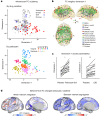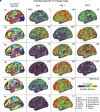Psilocybin desynchronizes the human brain
- PMID: 39020167
- PMCID: PMC11291293
- DOI: 10.1038/s41586-024-07624-5
Psilocybin desynchronizes the human brain
Abstract
A single dose of psilocybin, a psychedelic that acutely causes distortions of space-time perception and ego dissolution, produces rapid and persistent therapeutic effects in human clinical trials1-4. In animal models, psilocybin induces neuroplasticity in cortex and hippocampus5-8. It remains unclear how human brain network changes relate to subjective and lasting effects of psychedelics. Here we tracked individual-specific brain changes with longitudinal precision functional mapping (roughly 18 magnetic resonance imaging visits per participant). Healthy adults were tracked before, during and for 3 weeks after high-dose psilocybin (25 mg) and methylphenidate (40 mg), and brought back for an additional psilocybin dose 6-12 months later. Psilocybin massively disrupted functional connectivity (FC) in cortex and subcortex, acutely causing more than threefold greater change than methylphenidate. These FC changes were driven by brain desynchronization across spatial scales (areal, global), which dissolved network distinctions by reducing correlations within and anticorrelations between networks. Psilocybin-driven FC changes were strongest in the default mode network, which is connected to the anterior hippocampus and is thought to create our sense of space, time and self. Individual differences in FC changes were strongly linked to the subjective psychedelic experience. Performing a perceptual task reduced psilocybin-driven FC changes. Psilocybin caused persistent decrease in FC between the anterior hippocampus and default mode network, lasting for weeks. Persistent reduction of hippocampal-default mode network connectivity may represent a neuroanatomical and mechanistic correlate of the proplasticity and therapeutic effects of psychedelics.
© 2024. The Author(s).
Conflict of interest statement
Within the past year, J. S. Siegel has been an employee of Sumitomo Pharma America and received consulting fees from Longitude Capital. J. S. Siegel, N.U.F.D., T.O.L. and E.M.G. have submitted a provisional patent (patent no. 020949/US 15060-1787) for the use of precision functional mapping for measuring target engagement by experimental therapeutics. R.T.S. has received consulting compensation from Octave Bioscience and compensation for reviewership duties from the American Medical Association. C.L.R. serves as a consultant to Usona Institute and Novartis and receives research support from the Tiny Blue Dot Foundation. G.E.N. has received research support from Usona Institute (drug only). She has served as a paid consultant for Carelon, Alkermes, Inc., Sunovion Pharmaceuticals, Inc. and Novartis Pharmaceuticals Corp. T.O.L. holds a patent for taskless mapping of brain activity licenced to Sora Neurosciences and a patent for optimizing targets for neuromodulation, implant localization and ablation is pending. J. S. Siegel is a consultant and received stock options in Sora Neuroscience, and company that focuses on resting-state analysis. D.A.F. and N.U.F.D. are cofounders of Turing Medical Inc, have financial interest, may benefit financially if the company is successful in marketing FIRMM motion monitoring software products, may receive royalty income based on FIRMM technology developed at WUSOM and licenced to Turing Medical Inc. S.M.N., E.M.G. and T.O.L. have received consulting fees from Turing Medical Inc. D.F.W. is a consultant for Engrail Therapeutics and receives contract funds for WUSOM research studies from Eisai, Anavex and Roche. These potential conflicts of interest have been reviewed and are managed by WUSOM. The other authors declare no competing interests. All authors report no financial interest in psychedelics companies.
Figures













Update of
-
Psilocybin desynchronizes brain networks.medRxiv [Preprint]. 2023 Aug 24:2023.08.22.23294131. doi: 10.1101/2023.08.22.23294131. medRxiv. 2023. Update in: Nature. 2024 Aug;632(8023):131-138. doi: 10.1038/s41586-024-07624-5. PMID: 37701731 Free PMC article. Updated. Preprint.
Comment in
-
A psychedelic state arises from desynchronized brain activity.Nature. 2024 Aug;632(8023):32-33. doi: 10.1038/d41586-024-02154-6. Nature. 2024. PMID: 39020188 No abstract available.
References
MeSH terms
Substances
Grants and funding
- U24 DA041147/DA/NIDA NIH HHS/United States
- U01 DA051039/DA/NIDA NIH HHS/United States
- U01 DA041120/DA/NIDA NIH HHS/United States
- U01 DA041093/DA/NIDA NIH HHS/United States
- K99 MH129616/MH/NIMH NIH HHS/United States
- K23 NS123345/NS/NINDS NIH HHS/United States
- U24 DA041123/DA/NIDA NIH HHS/United States
- U01 DA051038/DA/NIDA NIH HHS/United States
- U01 DA051037/DA/NIDA NIH HHS/United States
- R00 MH129616/MH/NIMH NIH HHS/United States
- U01 DA041117/DA/NIDA NIH HHS/United States
- U01 DA041148/DA/NIDA NIH HHS/United States
- R44 MH121276/MH/NIMH NIH HHS/United States
- R44 NS129521/NS/NINDS NIH HHS/United States
- U01 DA041174/DA/NIDA NIH HHS/United States
- U01 DA051018/DA/NIDA NIH HHS/United States
- K23 NS088590/NS/NINDS NIH HHS/United States
- U01 DA041134/DA/NIDA NIH HHS/United States
- U01 DA041022/DA/NIDA NIH HHS/United States
- U01 DA041156/DA/NIDA NIH HHS/United States
- U01 DA050987/DA/NIDA NIH HHS/United States
- U01 DA051016/DA/NIDA NIH HHS/United States
- R01 NS124738/NS/NINDS NIH HHS/United States
- R01 MH118370/MH/NIMH NIH HHS/United States
- U01 DA041025/DA/NIDA NIH HHS/United States
- R25 MH112473/MH/NIMH NIH HHS/United States
- R01 MH096773/MH/NIMH NIH HHS/United States
- U01 DA050989/DA/NIDA NIH HHS/United States
- U01 DA041089/DA/NIDA NIH HHS/United States
- U01 DA050988/DA/NIDA NIH HHS/United States
- U01 DA041106/DA/NIDA NIH HHS/United States
- T32 DA007261/DA/NIDA NIH HHS/United States
- U01 DA041028/DA/NIDA NIH HHS/United States
- U01 DA041048/DA/NIDA NIH HHS/United States
- R44 MH124567/MH/NIMH NIH HHS/United States
- R44 MH122066/MH/NIMH NIH HHS/United States

